Reverse Sexism and Its Impact on Job Satisfaction and Career Planning: Italian Validation of the “Belief in Sexism Shift Scale”
Abstract
1. Introduction
1.1. Belief in Sexism Shift—A Definition
1.2. Belief in Sexism Shift as a Contemporary Manifestation of Anti-Female Sexism
1.3. BSS in Relation to Traditional and Modern Sexism
1.4. BSS in Relation to Hostile and Benevolent Sexism
1.5. BSS in Relation to Ambivalence towards Men
1.6. Present Research
2. Materials and Methods
2.1. Study 1
2.2. Participants and Procedure
2.3. Measures
2.3.1. Belief in Sexism Shift Scale—BSS
2.3.2. The Ambivalent Sexism Inventory—ASI
2.3.3. The Ambivalence towards Men Inventory—AMI
2.3.4. Old-Fashioned Sexism Scale
2.3.5. Modern Sexism Scale
2.4. Data Analysis
3. Results
3.1. Exploratory Factor Analysis
3.2. Confirmatory Factor Analysis
3.3. Convergent and Discriminant Validity
4. Study 2
4.1. Participants
4.2. Data Analysis
5. Results
5.1. Independent-Sample t-Test
5.2. Multiple-Group Confirmatory Factor Analysis (MCFA) for Gender
6. Study 3
6.1. Participants
6.2. Measures
6.2.1. Career Barriers Inventory-Revised (CBI-S)
6.2.2. Job Development Opportunities Scale
6.2.3. Job Satisfaction Survey
6.3. Data Analysis
6.4. Results
6.4.1. Path Analysis of the Different Sexism Scales on Career Barriers
6.4.2. The Moderation Model
7. Discussion
8. Limitation and Future Research
9. Conclusions
Author Contributions
Funding
Institutional Review Board Statement
Informed Consent Statement
Conflicts of Interest
References
- Aidos. 2022. Available online: https://aidos.it/wp-content/uploads/2020/12/MIND-THE-GAP-DEF-scheda-progetto-ita.pdf (accessed on 29 April 2023).
- Aiken, Leona S., Stephen G. West, and Raymond R. Reno. 1991. Multiple Regression: Testing and Interpreting Interactions. Newcastle upon Tyne: Sage. [Google Scholar]
- American Psychological Association. 2018. Sexism. APA Dictionary of Psychology [Internet]. Available online: https://dictionary.apa.org/sexism (accessed on 29 April 2023).
- Anderson, James C., and David W. Gerbing. 1988. Structural equation modeling in practice: A review and recommended two-step approach. Psychological Bulletin 103: 411. [Google Scholar] [CrossRef]
- Annovazzi, Chiara, Maria Cristina Ginevra, and Elisabetta Camussi. 2018. Gender and decent work: The role of occupational stereotypes. Interventions in Career Design and Education: Transformation for Sustainable Development and Decent Work 2018: 271–84. [Google Scholar]
- Bagozzi, Richard. 1994. Advanced Marketing Research. Hoboken: John Wiley & Sons. [Google Scholar]
- Bagozzi, Richard P., and Youjae Yi. 1988. On the evaluation of structural equation models. Journal of the Academy of Marketing Science 16: 74–94. [Google Scholar] [CrossRef]
- Bakker, Arnold B., and Evangelia Demerouti. 2014. Job demands–resources theory. Wellbeing: A Complete Reference Guide 2014: 1–28. [Google Scholar]
- Bauer-Wolf, Jeremy. 2018. Yale Being Investigated for Discrimination against Men in Unusual Title IX Complaint. Inside Higher Ed [Internet]. Available online: https://www.insidehighered.com/news/2018/05/21/yale-being-investigated-discrimination-against-men-unusual-title-ix-complaint (accessed on 29 April 2023).
- Beaton, Dorcas E., Claire Bombardier, Francis Guillemin, and Marcos Bosi Ferraz. 2000. Guidelines for the process of cross-cultural adaptation of self-report measures. Spine 25: 3186–91. [Google Scholar] [CrossRef]
- Bentler, Peter M., and Douglas G. Bonett. 1980. Significance tests and goodness of fit in the analysis of covariance structures. Psychological Bulletin 88: 588. [Google Scholar] [CrossRef]
- Bigler, Rebecca S., Carlo Tomasetto, and Sarah McKenney. 2019. Sexualization and youth: Concepts, theories, and models. International Journal of Behavioral Development 43: 530–40. [Google Scholar] [CrossRef]
- Blake, Khandis R., Rachel E. Hopkins, Joel G. Sprunger, Christopher I. Eckhardt, and Thomas F. Denson. 2018. Relationship quality and cognitive reappraisal moderate the effects of negative urgency on behavioral inclinations toward aggression and intimate partner violence. Psychology of Violence 8: 218. [Google Scholar] [CrossRef]
- Bosson, Jennifer Katherine, Joseph A. Vandello, Kenneth S. Michniewicz, and Joshua Guy Lenes. 2012. American men’s and women’s beliefs about gender discrimination: For men, it’s not quite a zero-sum game. Masculinities & Social Change 1: 210–39. [Google Scholar]
- Brooks, Clem, and Catherine Bolzendahl. 2004. The transformation of US gender role attitudes: Cohort replacement, social-structural change, and ideological learning. Social Science Research 33: 106–33. [Google Scholar] [CrossRef]
- Brooks, Khristopher. 2022. “White Guy” Case against AT&T Can Move Forward, Judge Says. CBS News. June 9. Available online: https://www.cbsnews.com/news/joseph-dibenedetto-att-race-gender-age-lawsuit-georgia/ (accessed on 29 April 2023).
- Byrne, Barbara M. 1998. Structural Equation Modeling with LISREL, PRELIS, and SIMPLIS: Basic Concepts, Applications, and Programming. [Google Scholar]
- Byrne, Barbara M. 2008. Testing for multigroup equivalence of a measuring instrument: A walk through the process. Psicothema 2008: 872–82. [Google Scholar]
- Byrne, Barbara M., Richard J. Shavelson, and Bengt Muthén. 1989. Testing for the equivalence of factor covariance and mean structures: The issue of partial measurement invariance. Psychological Bulletin 105: 456. [Google Scholar] [CrossRef]
- Campbell, Niloufar, Faraz Ali, Andrew Y. Finlay, and Sam S. Salek. 2008. Equivalence of electronic and paper-based patient-reported outcome measures. Quality of Life Research 24: 1949–61. [Google Scholar] [CrossRef]
- Caponnetto, Pasquale, Silvia Platania, Marilena Maglia, Martina Morando, Stefania Valeria Gruttadauria, Roberta Auditore, Caterina Ledda, Venerando Rapisarda, and Giuseppe Santisi. 2022. Health occupation and job satisfaction: The impact of psychological capital in the management of clinical psychological stressors of healthcare workers in the COVID-19 era. International Journal of Environmental Research and Public Health 19: 6134. [Google Scholar] [CrossRef]
- Cheung, Gordon W., and Rebecca S. Lau. 2008. Testing mediation and suppression effects of latent variables: Bootstrapping with structural equation models. Organizational Research Methods 11: 296–325. [Google Scholar] [CrossRef]
- Cohen, Jacob. 1988. Statistical Power Analysis for the Behavioral Sciences, 2nd ed. Hillsdale: Erlbaum. [Google Scholar]
- Cohen, Jacob, Patricia Cohen, Stephen G. West, and Leona S. Aiken. 2013. Applied Multiple Regression/Correlation Analysis for the Behavioral Sciences. Abingdon: Routledge. [Google Scholar]
- Diamantopoulos, Adamantios, Judy A. Siguaw, and Judy A. Siguaw. 2000. Introducing LISREL: A Guide for the Uninitiated. Newcastle upon Tyne: Sage. [Google Scholar]
- Donà, Alessia. 2010. La questione di genere in Italia: Oltre la parità formale. Studi e Ricerche AS 11: 691–700. [Google Scholar]
- Driesmans, Karolien, Laura Vandenbosch, and Steven Eggermont. 2015. Playing a videogame with a sexualized female character increases adolescents’ rape myth acceptance and tolerance toward sexual harassment. Games for Health Journal 4: 91–94. [Google Scholar] [CrossRef]
- ECWS. 2015. Discrimination against Men at Work: Experiences in Five Countries. Available online: https://www.eurofound.europa.eu/sites/default/files/ef_publication/field_ef_document/ef18046en.pdf (accessed on 29 April 2023).
- Elsesser, Kim. 2022. Stanford University under Investigation for Sex Bias—Against Men. Forbes. Available online: https://www.forbes.com/sites/kimelsesser/2022/11/30/stanford-university-under-investigation-for-sex-bias-against-men/?sh=1924e7683c17 (accessed on 29 April 2023).
- Fornell, Claes, and David F. Larcker. 1981. Structural equation models with unobservable variables and measurement error: Algebra and statistics. Journal of Marketing Research 18: 382–88. [Google Scholar] [CrossRef]
- Gallup, and International Labor Organization. 2017. Regional Tables and Country/Territory Dashboards [Internet]. Available online: http://www.ilo.org/wcmsp5/groups/public/—dgreports/—dcomm/—publ/documents/publication/wcms_546256.pdf (accessed on 29 April 2023).
- Glick, Peter, and Susan T. Fiske. 1996. The ambivalent sexism inventory: Differentiating hostile and benevolent sexism. Journal of Personality and Social Psychology 70: 491. [Google Scholar] [CrossRef]
- Glick, Peter, and Susan T. Fiske. 1999. The ambivalence toward men inventory: Differentiating hostile and benevolent beliefs about men. Psychology of Women Quarterly 23: 519–36. [Google Scholar] [CrossRef]
- Gramazio, Sarah, Mara Cadinu, Stefano Pagliaro, and Maria Giuseppina Pacilli. 2021. Sexualization of sexual harassment victims reduces bystanders’ help: The mediating role of attribution of immorality and blame. Journal of Interpersonal Violence 36: 6073–97. [Google Scholar] [CrossRef] [PubMed]
- Hackett, Gail, and Nancy E. Betz. 1981. A self-efficacy approach to the career development of women. Journal of Vocational Behavior 18: 326–39. [Google Scholar]
- Hayes, Andrew F. 2013. Mediation, moderation, and conditional process analysis. Introduction to Mediation, Moderation, and Conditional Process Analysis: A Regression-Based Approach 1: 20. [Google Scholar]
- Heilman, Madeline E., and Aaron S. Wallen. 2010. Wimpy and undeserving of respect: Penalties for men’s gender-inconsistent success. Journal of Experimental Social Psychology 46: 664–67. [Google Scholar] [CrossRef]
- Hooper, Daire, Joseph Coughlan, and Michael Mullen. 2008. Structural equation modelling: Guidelines for determining model fit. Electronic Journal of Business Research Methods 1: 53–60. [Google Scholar]
- Horn, John L., and J. Jack McArdle. 1992. A practical and theoretical guide to measurement invariance in aging research. Experimental Aging Research 18: 117–44. [Google Scholar] [CrossRef]
- Hu, Li-tze, and Peter M. Bentler. 1999. Cutoff criteria for fit indexes in covariance structure analysis: Conventional criteria versus new alternatives. Structural Equation Modeling: A Multidisciplinary Journal 6: 1–55. [Google Scholar] [CrossRef]
- Jetten, Jolanda, Nyla R. Branscombe, Aarti Iyer, and Nobako Asai. 2013. Appraising gender discrimination as legitimate or illegitimate: Antecedents and consequences. In Handbook of Gender and Psychology. London: Sage Publications, pp. 306–22. [Google Scholar]
- Kehn, Andre, and Joelle C. Ruthig. 2013. Perceptions of gender discrimination across six decades: The moderating roles of gender and age. Sex Roles 69: 289–96. [Google Scholar] [CrossRef]
- Lee, Wendy. 2016. Yahoo Faces Gender Discrimination Lawsuits from Two Men. San Francisco Chronicle [Internet]. Available online: https://www.sfchronicle.com/business/article/Yahoo-faces-gender-discrimination-lawsuits-from-9972811.php (accessed on 29 April 2023).
- Lomazzi, Vera. 2017. Gender role attitudes in Italy: 1988–2008—A path-dependency story of traditionalism. European Societies 19: 370–95. [Google Scholar] [CrossRef]
- MacCallum, Robert C., Michael W. Browne, and Hazuki M. Sugawara. 1996. Power analysis and determination of sample size for covariance structure modeling. Psychological Methods 1: 130. [Google Scholar] [CrossRef]
- Manganelli, Rattazzi, Anna Maria, Chiara Volpato, and Luigina Canova. 2008. L’atteggiamento ambivalente verso donne e uomini. Un contributo alla validazione delle scale ASI e AMI. Giornale Italiano di Psicologia 35: 217–46. [Google Scholar]
- Manzi, Francesca. 2019. Are the processes underlying discrimination the same for women and men? A critical review of congruity models of gender discrimination. Frontiers in Psychology 10: 469. [Google Scholar] [CrossRef] [PubMed]
- McKenny, Aaron F., Jeremy C. Short, and G. Tyge Payne. 2013. Using computer-aided text analysis to elevate constructs: An illustration using psychological capital. Organizational Research Methods 16: 152–84. [Google Scholar] [CrossRef]
- Meade, Adam W., Emily C. Johnson, and Phillip W. Braddy. 2008. Power and sensitivity of alternative fit indices in tests of measurement invariance. Journal of Applied Psychology 93: 568. [Google Scholar] [CrossRef] [PubMed]
- Meredith, William. 1993. Measurement invariance, factor analysis and factorial invariance. Psychometrika 58: 525–43. [Google Scholar] [CrossRef]
- Millsap, Roger E. 2012. Statistical Approaches to Measurement Invariance. New York: Routledge. [Google Scholar]
- Moscatelli, Silvia, Francesca Golfieri, Carlo Tomasetto, and Rebecca S. Bigler. 2021. Women and# MeToo in Italy: Internalized sexualization is associated with tolerance of sexual harassment and negative views of the# MeToo movement. Current Psychology 40: 6199–211. [Google Scholar]
- Moss-Racusin, Corinne A., Julie E. Phelan, and Laurie A. Rudman. 2010. When men break the gender rules: Status incongruity and backlash against modest men. Psychology of Men & Masculinity 11: 140. [Google Scholar]
- Mosso, Cristina, Giovanni Briante, Antonio Aiello, and Silvia Russo. 2013. The role of legitimizing ideologies as predictors of ambivalent sexism in young people: Evidence from Italy and the USA. Social Justice Research 26: 1–17. [Google Scholar] [CrossRef]
- Moya Morales, Miguel Carlos, and Alba Moya Garófano. 2021. Evolution of gender stereotypes in Spain: From 1985 to 2018. Psicothema 33: 53–59. [Google Scholar] [CrossRef]
- Mullen, Michael R. 1995. Diagnosing measurement equivalence in cross-national research. Journal of International Business Studies 26: 573–96. [Google Scholar] [CrossRef]
- Pacilli, Maria Giuseppina, Carlo Tomasetto, and Mara Cadinu. 2016. Exposure to sexualized advertisements disrupts children’s math performance by reducing working memory. Sex Roles 74: 389–98. [Google Scholar] [CrossRef]
- Payton, Mari, Dorian Hargrove, and Tom Jones. 2018. Gender Discrimination? Men Are Suing Women for Not Letting Them into Women-Only Events. NBC San Diego. Available online: https://www.nbcsandiego.com/news/local/Gender-Discrimination-Men-Are-Suing-Women-For-Not-Letting-Them-Into-Women-Only-Events-480880911.html (accessed on 29 April 2023).
- Perugini, Marco, Marcello Gallucci, and Giulio Costantini. 2018. A Practical Primer to Power Analysis for Simple Experimental Designs. International Review of Social Psychology 31: 20. [Google Scholar] [CrossRef]
- Platania, Silvia, Pasquale Caponnetto, Martina Morando, Marilena Maglia, Roberta Auditore, and Giuseppe Santisi. 2021. Cross-Cultural Adaptation, Psychometric Properties and Measurement Invariance of the Italian Version of the Job Satisfaction Scale. European Journal of Investigation in Health, Psychology and Education 11: 1073–87. [Google Scholar] [CrossRef] [PubMed]
- Podsakoff, Philip M., Scott B. MacKenzie, Jeong-Yeon Lee, and Nathan P. Podsakoff. 2003. Common method biases in behavioral research: A critical review of the literature and recommended remedies. Journal of Applied Psychology 88: 879–903. [Google Scholar] [CrossRef] [PubMed]
- Putnick, Diane L., and Marc H. Bornstein. 2016. Measurement invariance conventions and reporting: The state of the art and future directions for psychological research. Developmental Review 41: 71–90. [Google Scholar] [CrossRef]
- Raykov, Tenko. 1998. Coefficient alpha and composite reliability with interrelated nonhomogeneous items. Applied Psychological Measurement 22: 375–85. [Google Scholar] [CrossRef]
- Ruthig, Joelle C., Andre Kehn, Bradlee W. Gamblin, Karen Vanderzanden, and Kelly Jones. 2017. When women’s gains equal men’s losses: Predicting a zero-sum perspective of gender status. Sex Roles 76: 17–26. [Google Scholar] [CrossRef]
- Ryan, Michelle K., and Miriam K. Zehnter. 2022. Sexism today: Tools in the patriarchy’s toolbox. In Not Now Not Ever, Ten Years on from the Misogyny Speech. Edited by Julia Eileen Gillard. Tokyo: Vintage, pp. 99–120. [Google Scholar]
- Shevlin, Mark, and Jeremy N. V. Miles. 1998. Effects of sample size, model specification and factor loadings on the GFI in confirmatory factor analysis. Personality and Individual Differences 25: 85–90. [Google Scholar] [CrossRef]
- Singh, Jagdip. 1995. Measurement issues in cross-national research. Journal of International Business Studies 26: 597–619. [Google Scholar] [CrossRef]
- Spence, Janet T., Robert Helmreich, and Joy Stapp. 1973. A short version of the Attitudes toward Women Scale (AWS). Bulletin of the Psychonomic Society 2: 219–20. [Google Scholar] [CrossRef]
- Starr, Christine R., and Gail M. Ferguson. 2012. Sexy dolls, sexy grade-schoolers? Media & maternal influences on young girls’ self-sexualization. Sex Roles 67: 463–76. [Google Scholar]
- Steenkamp, Jan-Benedict E. M., and Hans Baumgartner. 1998. Assessing measurement invariance in cross-national consumer research. Journal of Consumer Research 25: 78–90. [Google Scholar] [CrossRef]
- Steiger, James H. 2007. Understanding the limitations of global fit assessment in structural equation modeling. Personality and Individual Differences 42: 893–98. [Google Scholar] [CrossRef]
- Steyn, Renier, and Gideon P. De Bruin. 2020. An investigation of gender-based differences in assessment instruments: A test of measurement invariance. SA Journal of Industrial Psychology 46: 1–12. [Google Scholar] [CrossRef]
- Sullivan, Kate Roy, and James R. Mahalik. 2000. Increasing career self-efficacy for women: Evaluating a group intervention. Journal of Counseling & Development 78: 54–62. [Google Scholar]
- Swanson, Jane L., and David M. Tokar. 1991. Development and initial validation of the Career Barriers Inventory. Journal of Vocational Behavior 39: 344–61. [Google Scholar] [CrossRef]
- Swanson, Jane L., Kimberly K. Daniels, and David M. Tokar. 1996. Assessing perceptions of career-related barriers: The Career Barriers Inventory. Journal of Career Assessment 4: 219–44. [Google Scholar] [CrossRef]
- Swim, Janet K., Kathryn J. Aikin, Wayne S. Hall, and Barbara A. Hunter. 1995. Sexism and racism: Old-fashioned and modern prejudices. Journal of Personality and Social Psychology 68: 199. [Google Scholar] [CrossRef]
- Tabachnick, Barbara G., and Linda S. Fidell. 2007. Experimental Designs Using ANOVA. Belmont: Thomson/Brooks/Cole, vol. 724. [Google Scholar]
- Van de Schoot, Rens, Peter Lugtig, and Joop Hox. 2012. A checklist for testing measurement invariance. European Journal of Developmental Psychology 9: 486–92. [Google Scholar] [CrossRef]
- Vandenberg, Robert J., and Charles E. Lance. 2000. A review and synthesis of the measurement invariance literature: Suggestions, practices, and recommendations for organizational research. Organizational Research Methods 3: 4–70. [Google Scholar] [CrossRef]
- Wilkins, Clara L., Joseph D. Wellman, and Katherine D. Schad. 2017. Reactions to anti-male sexism claims: The moderating roles of status-legitimizing belief endorsement and group identification. Group Processes & Intergroup Relations 20: 173–85. [Google Scholar]
- World Economic Forum. 2022. Available online: https://www3.weforum.org/docs/WEF_GGGR_2022.pdf (accessed on 29 April 2023).
- Zehnter, Miriam K., Francesca Manzi, Patrick E. Shrout, and Madeline E. Heilman. 2021. Belief in sexism shift: Defining a new form of contemporary sexism and introducing the belief in sexism shift scale (BSS scale). PLoS ONE 16: e0248374. [Google Scholar] [CrossRef] [PubMed]
- Zula, Kenneth. 2014. The Future of Nontraditional Occupations for Women: A Comprehensive Review of The Literature and Implications for Workplace Learning and Performance. Journal of Diversity Management (JDM) 9: 7–18. [Google Scholar] [CrossRef]
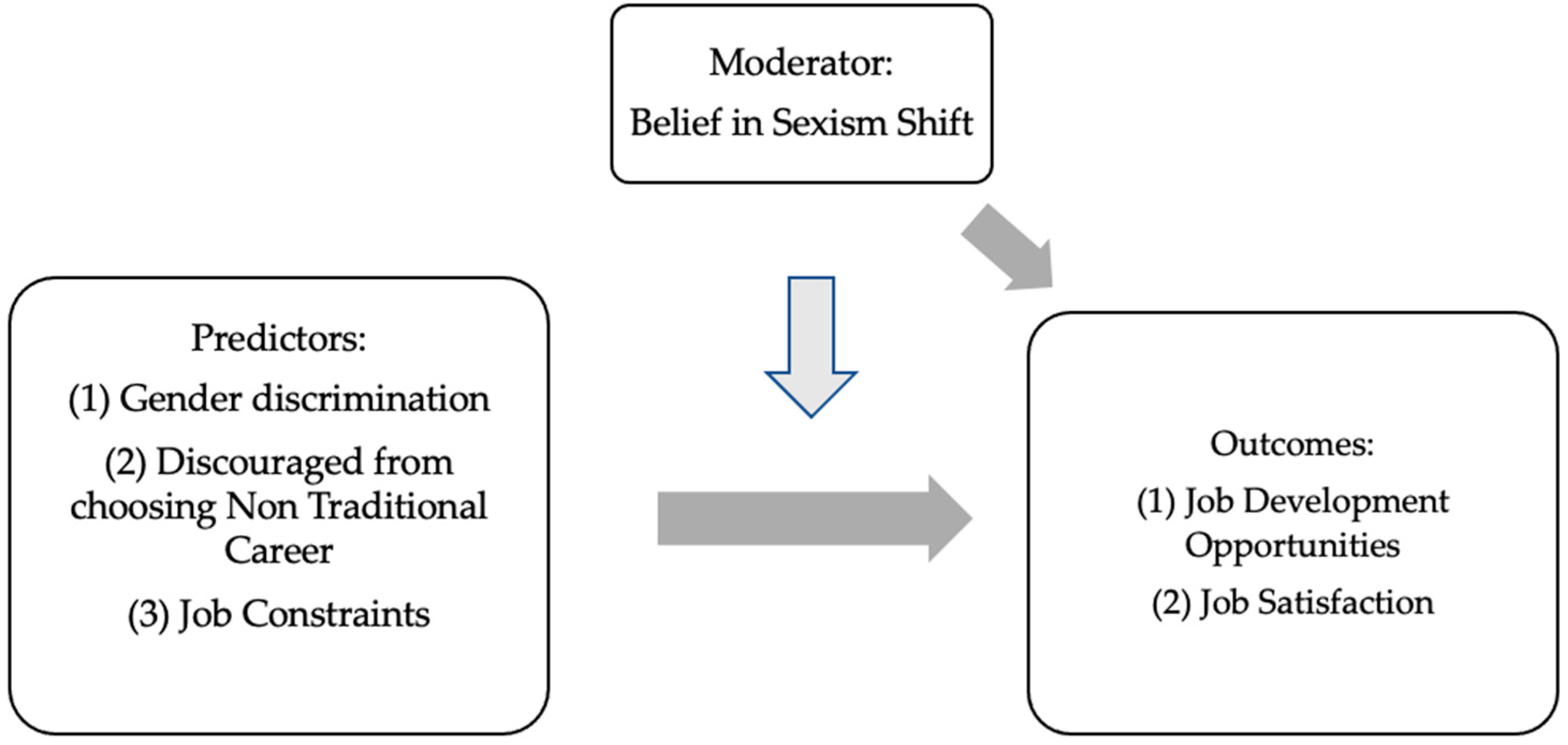
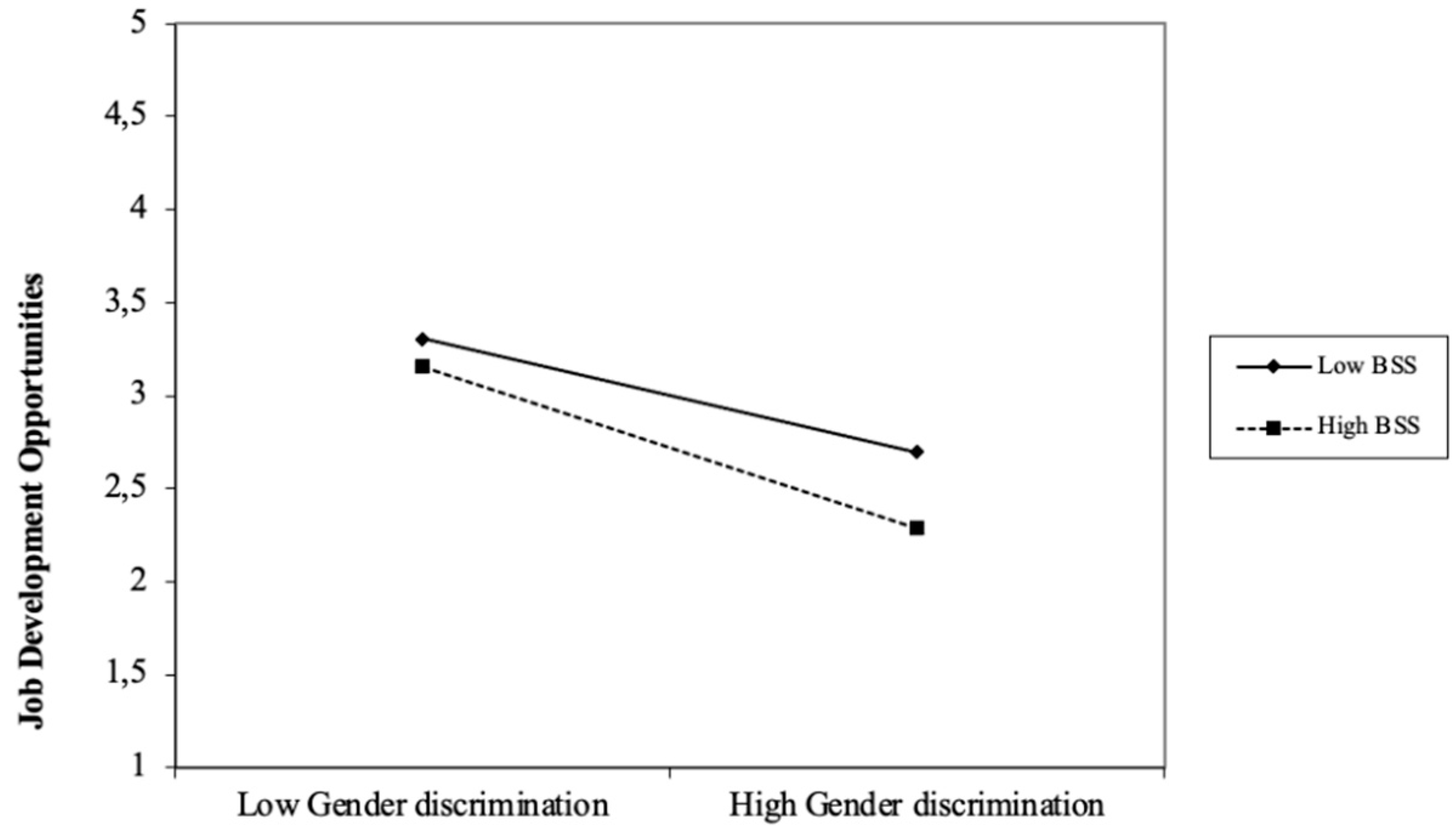
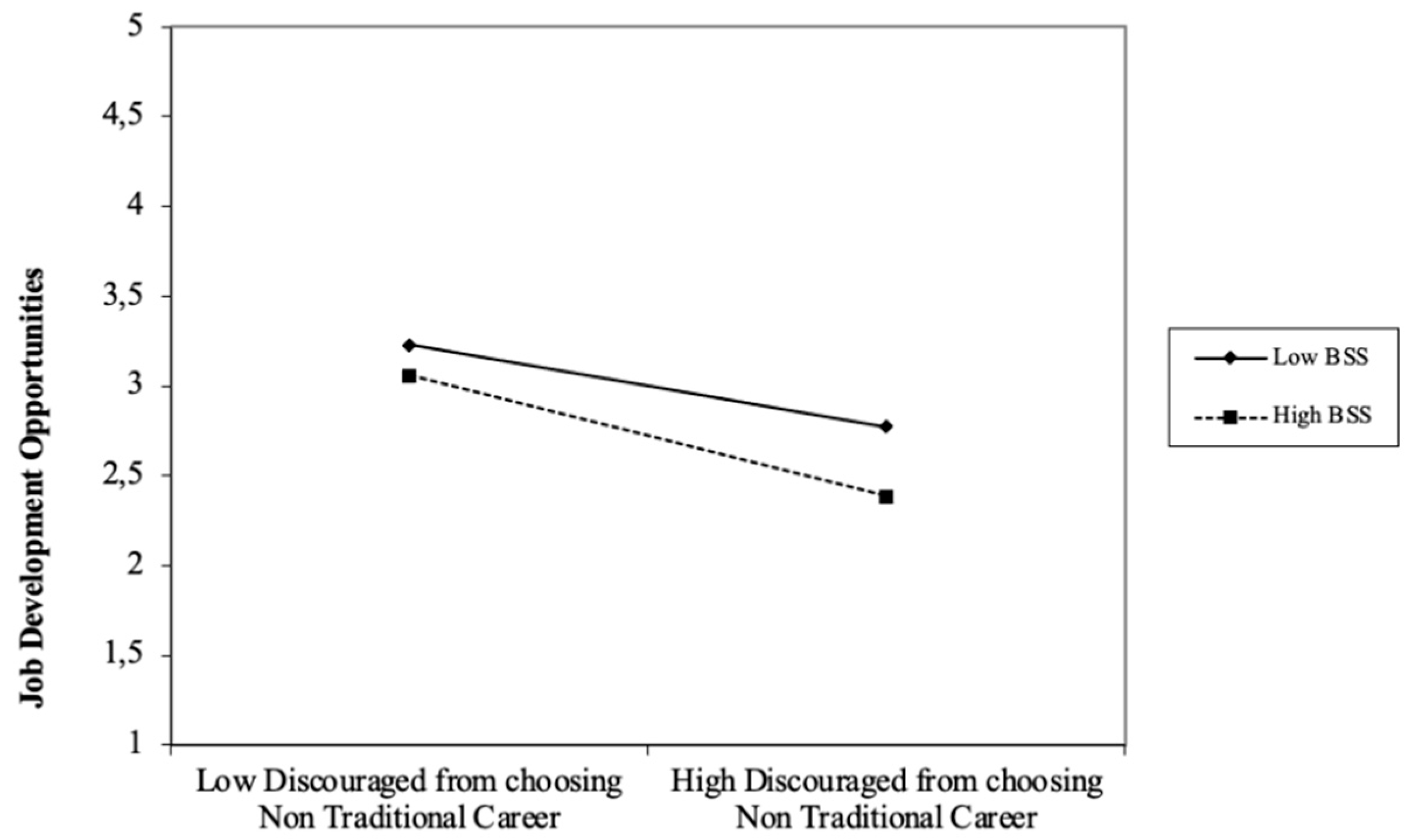
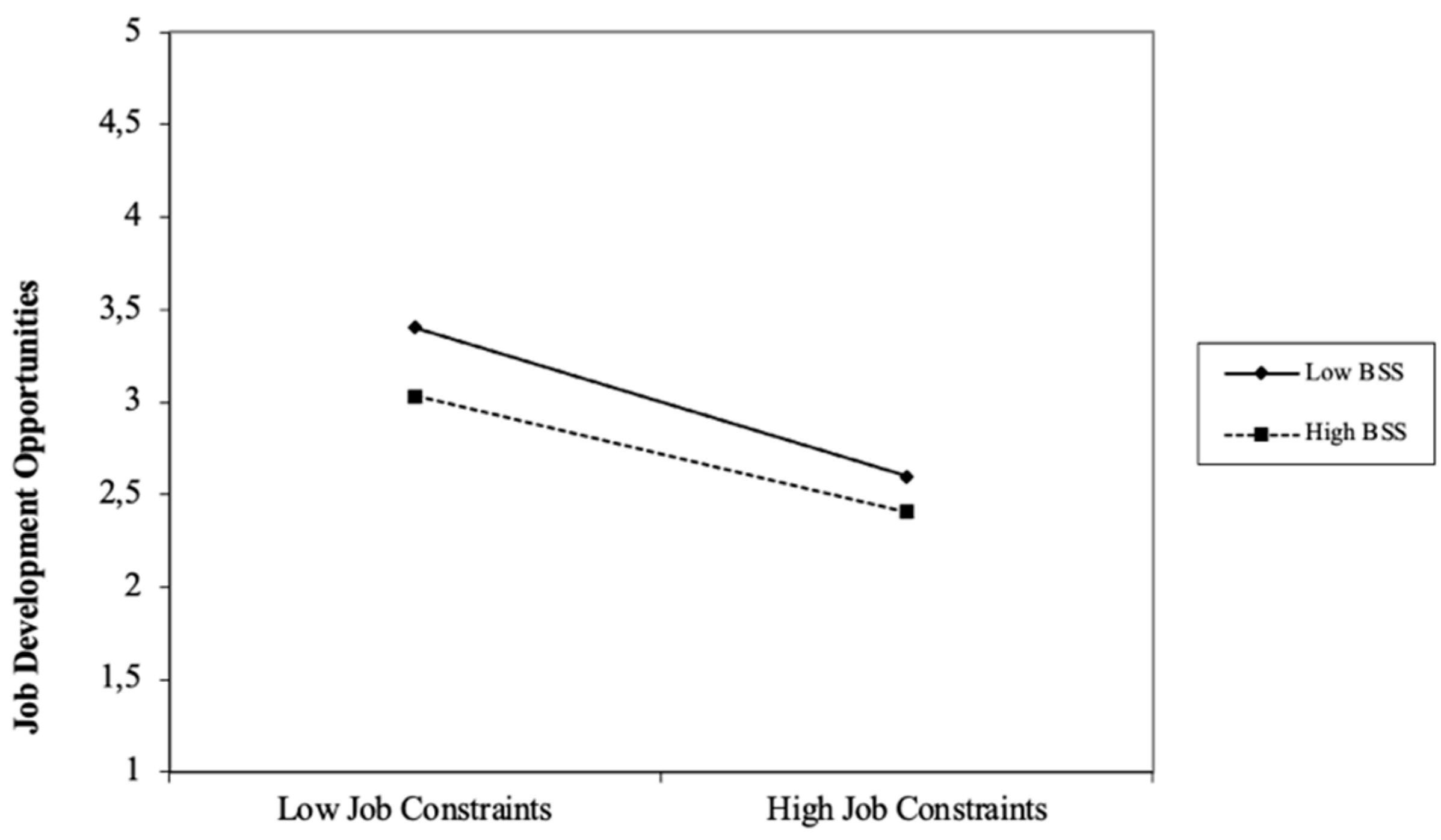
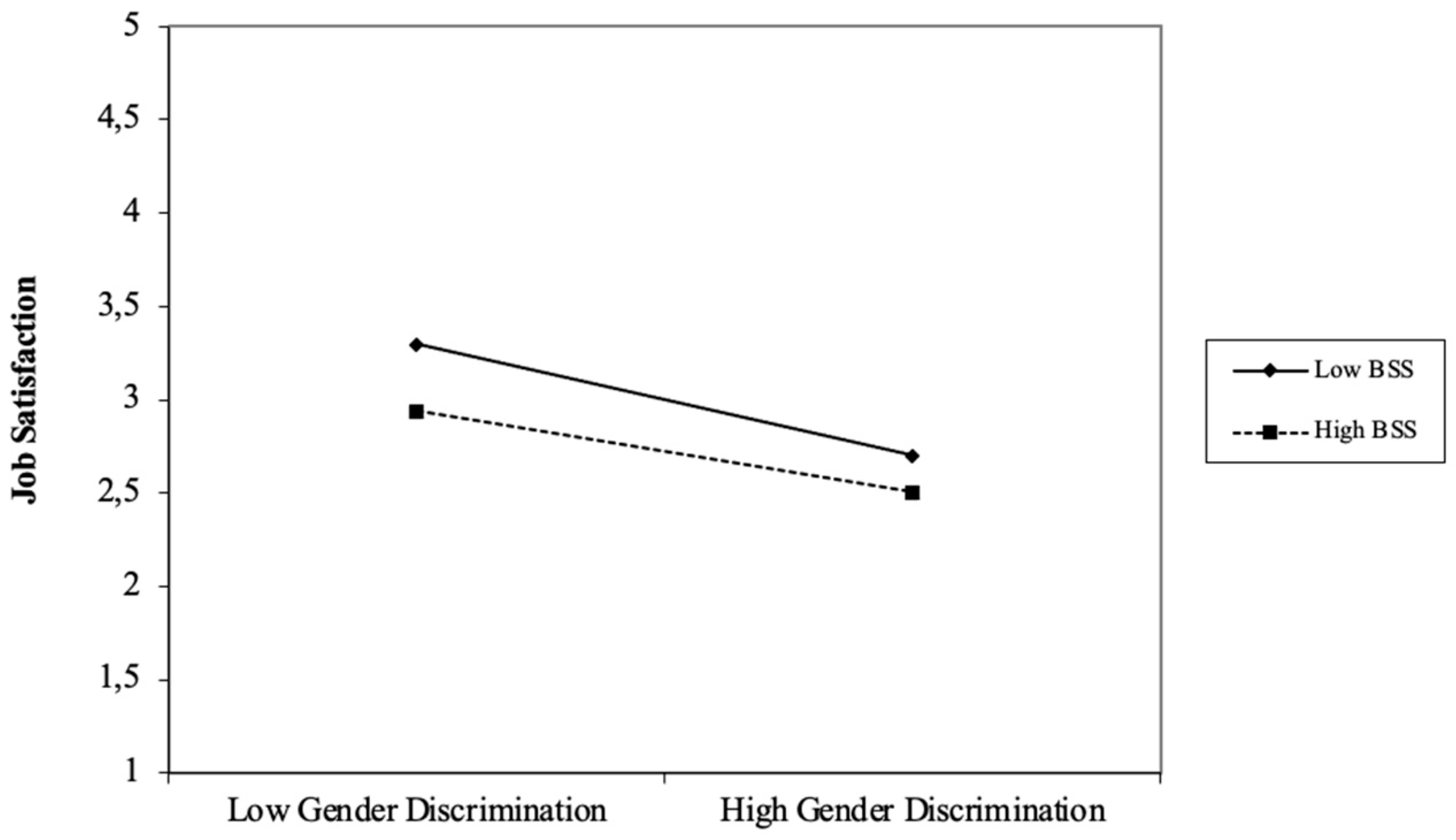
| Original Scale | M(SD) | Italian Scale | M(SD) |
|---|---|---|---|
| BSS1 In the US, discrimination against men is on the rise. | 3.13 (1.9) | In Italia la discriminazione nei confronti degli uomini è in aumento. | 2.83 (1.5) |
| BSS2 Giving women more rights often requires taking away men’s rights. | 2.43 (1.7) | Dare più diritti alle donne spesso richiede di togliere diritti agli uomini. | 1.97 (1.3) |
| BSS3 Nowadays, men don’t have the same chances in the job market as women. | 2.44 (1.7) | Oggi gli uomini non hanno le stesse possibilità delle donne nel mercato del lavoro. | 3.10 (1.6) |
| BSS4 All in all, men have more responsibilities and fewer benefits. | 2.95 (1.9) | Nel complesso, gli uomini hanno più responsabilità e meno vantaggi. | 2.87 (1.4) |
| BSS5 Feminism does not discriminate against men. * | 3.54 (2.5) | Il femminismo non discrimina gli uomini. | 3.32 (1.9) |
| BSS6 Men are not particularly discriminated against. * | 3.14 (1.8) | Gli uomini non sono particolarmente discriminate. | 3.41 (1.8) |
| BSS7 Under the guise of equality for women, men are actually being discriminated against. | 2.94 (1.9) | Con la scusa dell’uguaglianza per le donne, gli uomini vengono in realtà discriminate. | 2.92 (1.5) |
| BSS8 In today’s society, men are often punished for acting manly. | 3.09 (1.9) | Nella società odierna, gli uomini sono spesso puniti per essersi comportati da uomini. | 2.40 (1.6) |
| BSS9 While women can use the “gender-card” to get ahead, men can’t. | 3.66 (2.1) | Mentre le donne possono usare la “carta dell’essere donne” per andare avanti, gli uomini non possono. | 3.35 (1.8) |
| BSS10 If anything, men are more discriminated against than women these days. | 2.55 (1.8) | Semmai, oggi gli uomini sono più discriminati delle donne. | 2.27 (1.3) |
| BSS11 In today’s society, women can say things that men are not allowed to say. | 3.66 (2) | Nella società di oggi, le donne possono dire cose che agli uomini non sono permesse. | 3.33 (1.8) |
| BSS12 All in all, men are well respected in today’s society. * | 2.66 (1.5) | Nel complesso, gli uomini sono ben rispettati nella società di oggi. | 2.84 (1.4) |
| BSS13 Feminism is about favoring women over men. | 3.12 (2.1) | Il femminismo consiste nel favorire le donne rispetto agli uomini. | 2.79 (1.6) |
| BSS14 In the pursuit of women’s rights, the government has neglected men’s rights. | 2.89 (1.9) | Nel perseguire i diritti delle donne, il governo ha trascurato i diritti degli uomini. | 2.43 (1.5) |
| BSS15 It is evident that the media is biased against men. | 3.02 (1.9) | È evidente che i media sono prevenuti nei confronti degli uomini. | 2.95 (1.8) |
| Factor Loading Original Scale | Factor Loading Italian Scale | |
|---|---|---|
| BSS1 | 0.87 | 0.80 |
| BSS2 | 0.75 | 0.82 |
| BSS3 | 0.77 | 0.53 |
| BSS4 | 0.83 | 0.78 |
| BSS5 | 0.74 | 0.72 |
| BSS6 | 0.68 | 0.62 |
| BSS7 | 0.92 | 0.85 |
| BSS8 | 0.83 | 0.77 |
| BSS9 | 0.79 | 0.75 |
| BSS10 | 0.91 | 0.83 |
| BSS11 | 0.68 | 0.79 |
| BSS12 | 0.61 | 0.62 |
| BSS13 | 0.83 | 0.64 |
| BSS14 | 0.87 | 0.82 |
| BSS15 | 0.87 | 0.76 |
| Skewness | Kurtosis | |
|---|---|---|
| BSS1 | 0.614 | −0.564 |
| BSS2 | 1.709 | 1.106 |
| BSS3 | 1.120 | 0.403 |
| BSS4 | 1.313 | 0.811 |
| BSS5 | 0.476 | −1.125 |
| BSS6 | 0.351 | −0.929 |
| BSS7 | 1.057 | 0.279 |
| BSS8 | 1.017 | 0.309 |
| BSS9 | 0.970 | −.354 |
| BSS10 | 1.633 | 1.994 |
| BSS11 | 0.709 | −0.914 |
| BSS12 | 0.737 | 0.134 |
| BSS13 | 1.500 | 1.178 |
| BSS14 | 1.529 | 1.434 |
| BSS15 | 0.806 | −0.544 |
| α | CR | AVE | 1 | 2 | 3 | 4 | 5 | 6 | 7 | ||
|---|---|---|---|---|---|---|---|---|---|---|---|
| 1 | Belief in sexism shift (BSS) | 0.92 | 0.92 | 0.55 | 1 | ||||||
| 2 | Hostile sexism (ASI) | 0.84 | 0.86 | 0.51 | 0.71 ** | 1 | |||||
| 3 | Benevolent sexism (ASI) | 0.79 | 0.85 | 0.50 | 0.28 ** | 0.44 * | 1 | ||||
| 4 | Hostility against men (AMI) | 0.77 | 0.86 | 0.52 | −0.59 ** | −0.25 ** | −0.44 ** | 1 | |||
| 5 | Benevolence against men (AMI) | 0.81 | 0.85 | 0.51 | 0.64 ** | 0.71 ** | 0.64 ** | −0.29 ** | 1 | ||
| 6 | Old-fashioned sexism | 0.72 | 0.76 | 0.51 | 0.40 ** | 0.39 ** | 0.26 ** | −0.13 ** | 0.43 ** | 1 | |
| 7 | Modern sexism | 0.81 | 0.79 | 0.54 | 0.23 ** | 0.59 ** | 0.19 ** | −0.12 ** | 0.54 ** | 0.35 ** | 1 |
| Women M (SD) | Men M (SD) | t | p | |
|---|---|---|---|---|
| BSS1 | 2.24 (1.3) | 3.43 (1.7) | 8.62 | <0.001 |
| BSS2 | 1.54 (1.1) | 2.32 (1.5) | 7.31 | <0.001 |
| BSS3 | 2.93 (1.6) | 3.27 (1.6) | 1.93 | 0.171 |
| BSS4 | 2.55 (0.9) | 3.14 (1.8) | 6.67 | <0.001 |
| BSS5 | 2.58 (1.9) | 4.11 (1.9) | 9.53 | 0.275 |
| BSS6 | 3.0 (1.7) | 3.70 (1.8) | 4.52 | 0.16 |
| BSS7 | 2.71 (1.2) | 3.13 (1.8) | 5.56 | <0.001 |
| BSS8 | 1.91 (1.4) | 2.91 (1.7) | 8.07 | <0.001 |
| BSS9 | 2.92 (1.6) | 3.63 (2) | 7.58 | <0.001 |
| BSS10 | 1.97 (1) | 2.43 (1.6) | 8.13 | <0.001 |
| BSS11 | 2.81 (1.6) | 3.76 (2.0) | 6.21 | <0.001 |
| BSS12 | 2.42 (1.3) | 3.11 (1.5) | 5.82 | 0.236 |
| BSS13 | 2.51 (1.2) | 2.81 (1.9) | 8.66 | <0.001 |
| BSS14 | 2.22 (1.1) | 2.62 (1.8) | 5.12 | <0.001 |
| BSS15 | 2.50 (1.6) | 3.21 (1.9) | 7.02 | <0.001 |
| Model | χ2 (df) | CFI | SRMR | RMSEA | ΔCFI |
|---|---|---|---|---|---|
| 1. Configural Invariance | 335.566 (172) | 0.949 | 0.039 | 0.042 (0.035–0.049) | - |
| 2. Metric Invariance | 382.434 (186) | 0.939 | 0.046 | 0.044 (0.038–0.051) | 0.01 |
| 3. Scalar Invariance | 452.787 (201) | 0.89 | 0.079 | 0.06 (0.055–0.066) | 0.04 |
| 4. Partial Scalar Invariance | 397.436 (198) | 0.933 | 0.081 | 0.054 (0.041–0.053) | 0.01 |
| 5. Measurement Error Invariance | 435.882 (211) | 0.923 | 0.0875 | 0.05 (0.044–0.056) | 0.01 |
| Estimate | S.E. | C.R. | Sig. | |
|---|---|---|---|---|
| Gender Discrimination ← BSS | 0.248 | 0.083 | 3.554 | <0.001 |
| Gender Discrimination ← Hostile ASI | 0.154 | 0.077 | 2.593 | 0.01 |
| Multiple-Role Conflict ← Hostile ASI | 0.121 | 0.089 | 3.221 | 0.01 |
| Racial Discrimination ← BSS | 0.241 | 0.082 | 2.584 | 0.003 |
| Discouraged From Choosing Non-Traditional Career ← BSS | 0.20 | 0.079 | 1.887 | 0.01 |
| Job Market Constraints ← BSS | 0.281 | 0.085 | 2.986 | 0.002 |
| Difficulties With Socialisation ← Modern Sexism | 0.119 | 0.069 | 1.923 | 0.3 |
| Job Development Opportunities | Job Satisfaction | |
|---|---|---|
| Step 1 | β | β |
| Gender Discrimination | −0.31 * | −0.20 * |
| Discouraged from choosing Non-Traditional Career | −0.22 * | −0.28 * |
| Job Constraints Step 2 | 0.40 * | 0.31 * |
| BSS Step 3 | −0.28 * | −0.23 * |
| Gender discrimination X BSS | 0.13 * | 0.08 * |
| Discouraged from Choosing Non-Traditional Career X BSS | 0.11 * | 0.10 |
| Job Constraints X BSS | 0.09 * | 0.06 |
| Job Development Opportunities | Job Satisfaction | |||
|---|---|---|---|---|
| Men | Women | Men | Women | |
| Step 1 | β | β | β | β |
| Gender Discrimination | −0.24 * | −0.38 * | −0.18 * | −0.22 * |
| Discouraged from Choosing Non-Traditional Career | −0.17 * | −0.27 * | −0.26 * | −0.30 * |
| Job Constraints Step 2 | 0.42 * | 0.38 * | 0.35 * | 0.27 * |
| BSS Step 3 | −0.31 * | −0.25 * | −0.24 * | −0.21 * |
| Gender Discrimination X BSS | 0.06 * | 0.20 * | 0.07 * | 0.09 * |
| Discouraged from Choosing Non-Traditional Career X BSS | 0.15 * | 0.12 * | 0.16 * | 0.12 * |
| Job Constraints X BSS | 0.13 * | n.s. | n.s. | n.s. |
Disclaimer/Publisher’s Note: The statements, opinions and data contained in all publications are solely those of the individual author(s) and contributor(s) and not of MDPI and/or the editor(s). MDPI and/or the editor(s) disclaim responsibility for any injury to people or property resulting from any ideas, methods, instructions or products referred to in the content. |
© 2023 by the authors. Licensee MDPI, Basel, Switzerland. This article is an open access article distributed under the terms and conditions of the Creative Commons Attribution (CC BY) license (https://creativecommons.org/licenses/by/4.0/).
Share and Cite
Morando, M.; Zehnter, M.K.; Platania, S. Reverse Sexism and Its Impact on Job Satisfaction and Career Planning: Italian Validation of the “Belief in Sexism Shift Scale”. Soc. Sci. 2023, 12, 357. https://doi.org/10.3390/socsci12060357
Morando M, Zehnter MK, Platania S. Reverse Sexism and Its Impact on Job Satisfaction and Career Planning: Italian Validation of the “Belief in Sexism Shift Scale”. Social Sciences. 2023; 12(6):357. https://doi.org/10.3390/socsci12060357
Chicago/Turabian StyleMorando, Martina, Miriam Katharina Zehnter, and Silvia Platania. 2023. "Reverse Sexism and Its Impact on Job Satisfaction and Career Planning: Italian Validation of the “Belief in Sexism Shift Scale”" Social Sciences 12, no. 6: 357. https://doi.org/10.3390/socsci12060357
APA StyleMorando, M., Zehnter, M. K., & Platania, S. (2023). Reverse Sexism and Its Impact on Job Satisfaction and Career Planning: Italian Validation of the “Belief in Sexism Shift Scale”. Social Sciences, 12(6), 357. https://doi.org/10.3390/socsci12060357








